Matt
Betta Fish Behavior Before Death

Watching your Betta fish struggle in its final days can be an emotionally taxing experience. Recognizing the signs of decline early can give you a chance to intervene, provide comfort, or prepare for what’s to come. Here’s how to identify the most common signs that your Betta is nearing the end and what you can do to make their last days as peaceful as possible.
****Spotting the Warning Signs of Betta Fish Decline – Don’t Wait Until It’s Too Late
To help you quickly identify critical signs, here’s a comparison chart showing common Betta fish behaviors in healthy vs. dying fish:
| Behavior | Healthy Betta | Dying Betta |
|---|---|---|
| Activity Level | Active, exploring | Lethargic, barely moving |
| Appetite | Eager, responsive to feeding | Refuses food, spits out food |
| Fins | Spread out, vibrant | Clamped, torn, discolored |
| Swimming Pattern | Smooth, controlled | Erratic, floating sideways |
| Breathing | Calm, rhythmic | Rapid, gasping at surface |
| Color | Bright, vibrant | Dull, faded, pale |
| Skin/Scales | Smooth, clear | White patches, lesions |
| Balance | Steady | Floating, sinking, struggling |
Click here for Our eBook and Save Your Betta!
Bettas are known for their vivid colors and lively personalities, but when they’re nearing the end of their life, their behavior changes dramatically. Look for these critical signs:
Lethargy and Decreased Activity – The First Signs of Trouble
When a once-active Betta spends more time lying at the bottom of the tank or floating listlessly, it’s often a sign of declining health. This can be caused by poor water conditions, stress, or underlying illness. Learn more about water parameters here.
What to Do:
- Test water parameters for ammonia, nitrites, and pH.
- Maintain water temperature between 78-80°F.
- Add aquarium salt to reduce stress and discomfort.
Loss of Appetite – A Disturbing Indicator
If your Betta suddenly refuses food or spits it out, it could indicate stress, infection, or digestive problems. Bettas typically have a strong appetite, so ignoring food is a significant warning sign.
What to Do:
- Isolate the Betta in a separate hospital tank.
- Offer soft, easy-to-digest foods like brine shrimp or daphnia.
- Administer anti-parasitic or anti-bacterial treatments if necessary.
- Learn more about a betta that’s not eating.
Clamped Fins – A Clear Sign of Stress or Sickness
Healthy Betta fins fan out gracefully. When they stay clamped close to the body, it usually signals distress or infection. Stress from poor water conditions, parasites, or bacterial infections can cause this.
What to Do:
- Improve water quality through frequent water changes.
- Apply a stress coat to the water to soothe irritated skin.
- Treat with antibacterial medication if fins appear frayed or deteriorating.
Erratic Swimming and Floating Issues – Is Your Betta Losing Control?
A Betta struggling to swim properly may have swim bladder disease. This condition can cause them to float sideways, sink, or wobble uncontrollably.
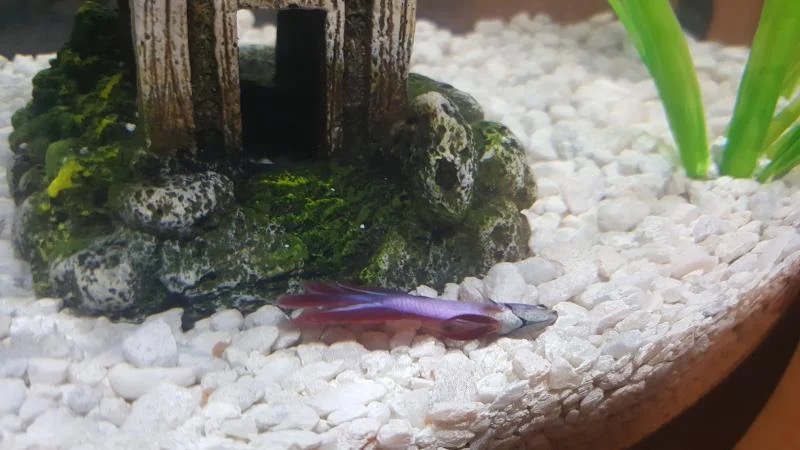
What to Do:
- Fast the Betta for 24 hours to alleviate constipation.
- Lower the water level to make swimming less strenuous.
- Add Indian almond leaves to calm the fish and reduce inflammation.
- Learn more about float issues and swim bladder disease.
Labored Breathing – Gasping for Air
Gasping at the surface or rapid gill movement often indicates that the Betta is struggling to get enough oxygen. This could be due to ammonia poisoning, poor water quality, or a bacterial infection.
What to Do:
- Perform a 50% water change to reduce toxins.
- Increase oxygenation with a gentle air stone.
- Treat for gill parasites or bacterial infections as needed.
Color Fading – When Vibrance Turns to Dullness
A once-vibrant Betta that appears dull or pale is likely under stress or suffering from illness. This symptom is common in aging fish but can also signal severe stress.
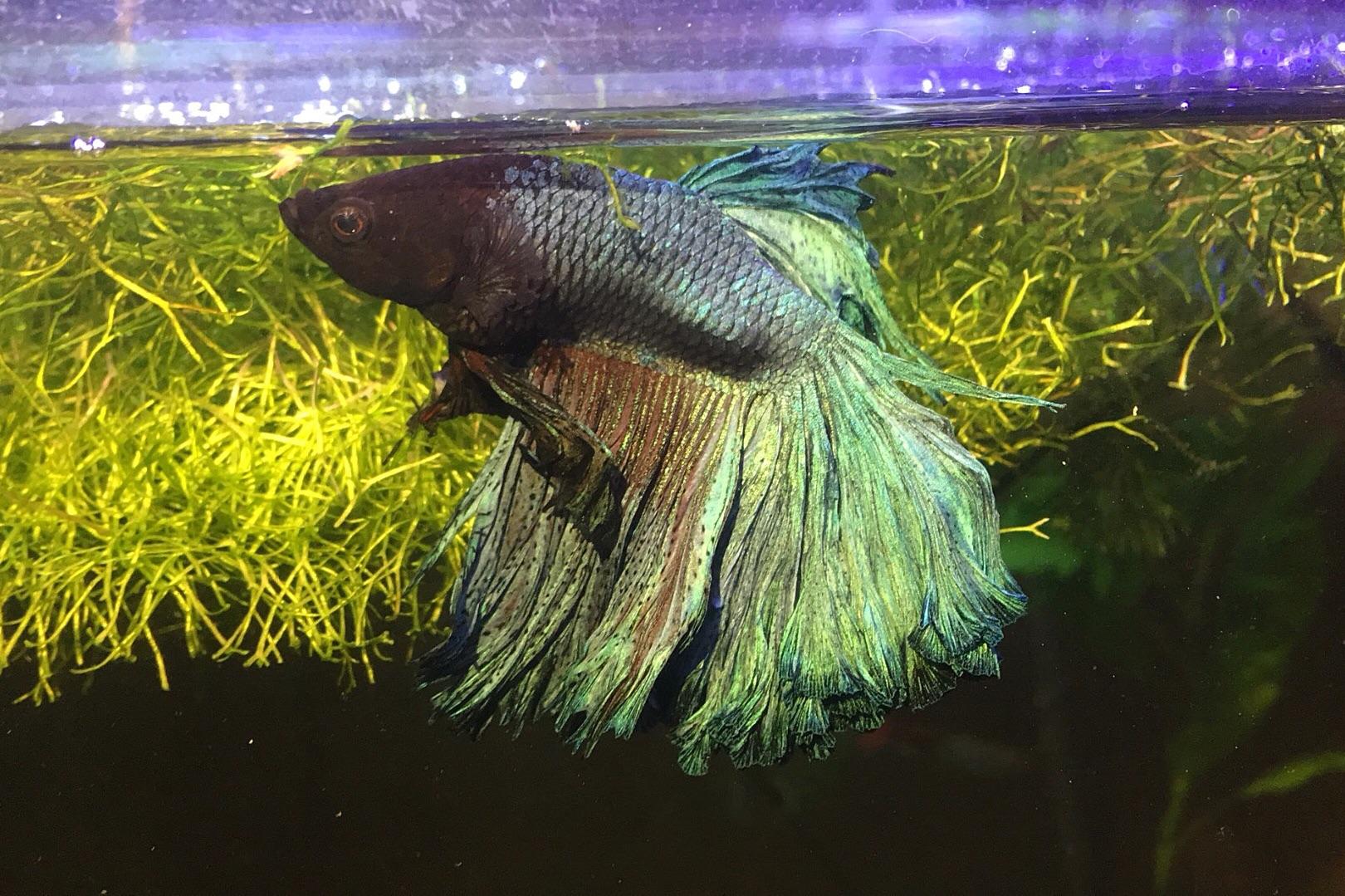
What to Do:
- Maintain stable water conditions to minimize stress.
- Offer nutrient-rich foods to strengthen their immune system.
- Remove aggressive tank mates to prevent bullying.
- More about color fading issues and how to bring their vibrance back.
White Patches, Fungal Growths, or Parasites – The Signs of a Severe Infection
If your Betta has white cotton-like patches, small spots, or unusual skin lesions, it may be suffering from a fungal infection, Ich, or other parasites.
What to Do:
- Increase the water temperature to 82°F to inhibit parasites.
- Apply antifungal or antiparasitic treatments as needed.
- Isolate the Betta to prevent the spread of infection.
- Learn more about betta fish fungus.
Fin Rot – The Silent Killer
Fin rot causes the edges of the fins to fray and blacken. It is typically caused by bacteria in unclean water and can rapidly deteriorate a Betta’s health.
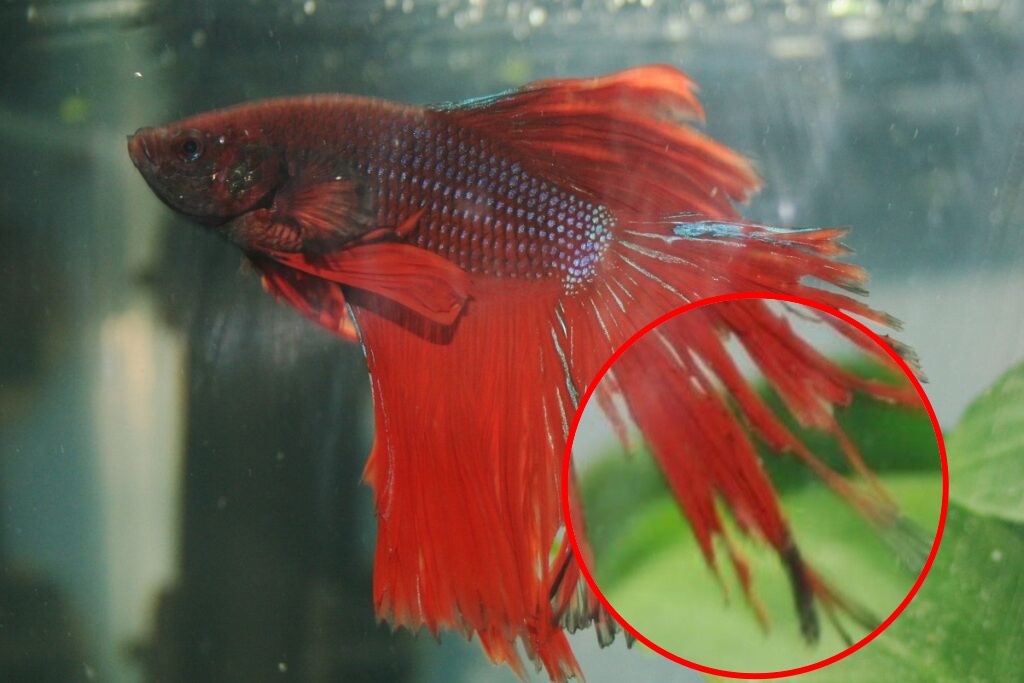
What to Do:
- Isolate the Betta in a hospital tank.
- Administer antibacterial medication.
- Perform regular water changes to prevent further infection.
- Learn more about fin rot treatments here.
Loss of Balance – The Last Cry for Help
If your Betta is floating sideways, upside down, or struggling to stay upright, it may have swim bladder disorder or neurological issues.
What to Do:
- Fast for 24 hours to relieve constipation.
- Administer Epsom salt baths to reduce swelling.
- Lower the water level to minimize exertion.
How to Comfort a Dying Betta Fish – Creating a Peaceful End
If your Betta shows multiple signs of decline and treatment isn’t working, it’s time to focus on comfort care. Here’s how to make their final days as calm and pain-free as possible. Here’s how to provide a calm and peaceful environment:
- Reduce water flow to prevent stress.
- Offer soft, easy-to-digest foods like frozen brine shrimp.
- Keep the tank dimly lit to minimize stress.
- Maintain a consistent water temperature to avoid shocks.
Is Euthanasia the Kindest Option? When to Let Go
If your Betta’s condition continues to worsen despite treatment, humane euthanasia may be the kindest choice to prevent further suffering. The most accepted method is using clove oil, which induces a painless sleep.
Preventing Betta Fish Decline – How to Keep Your Betta Thriving
Consistent care can prevent many health issues in Bettas. Here are some essential practices:
- Test water parameters weekly to catch early signs of water quality issues.
- Maintain a stable temperature and use a heater to prevent temperature shock.
- Quarantine new fish buddies before introducing them to the main tank.
- Avoid overfeeding and maintain a varied diet to promote digestion and prevent constipation.
How To Treat Betta Fish Suffering From Velvet
Betta fish, with their dazzling beauty, are remarkably resilient creatures. However, like any living being, they can fall ill. One potential illness to be aware of is velvet, a parasite that can pose a significant threat to your betta. But fear not! With the right plan, you can effectively treat velvet and help your betta regain their vibrant health.
What is Velvet?
Velvet isn’t a fabric mishap on your betta. It’s a nasty parasite clinging to your fish’s skin and fins. Here’s how to spot it:
- Golden Dust: Look closely. Does your betta’s color seem off? Velvet can make them look like they’re covered in fine, gold or rust-colored dust.
- Scratching: Parasites are itchy! Your betta might rub against things in the tank like they’re trying to scratch an itch they can’t reach.
- Strange Swimming: Velvet can make your betta uncomfortable, causing them to swim erratically or clamp their fins close to their body.
- Loss of Appetite: When a fish doesn’t feel well, they often don’t want to eat.
Treating Velvet
Click here if you want to learn how to cure velvet
Velvet is a serious condition, so it’s crucial to start treatment immediately upon spotting the signs. By doing so, you’re taking a proactive and responsible approach to your betta’s health. Here’s what you need to do:
- Isolate: Velvet is highly contagious. If you have other fish in the tank, immediately move your betta to a separate “hospital tank” for treatment.
- Dim the Lights: These parasites don’t like bright light. Dimming your betta’s tank or covering it with a towel can help disrupt their life cycle.
- Raise the Temperature (Carefully): Raising your tank water temperature to around 82°F speeds up the life cycle of the parasites, making treatment more effective. Caution: Do this slowly over a day or two; sudden temperature changes stress bettas.
Treat with Medications: Several medications can combat velvet. Here are some commonly used options:
- Malachite Green: This is a traditional anti-parasite treatment. Follow the dosage directions carefully.
- Copper Sulfate is another effective option, but be very precise with the dosage as it can be toxic to fish.
- Aquarium Salt: Not a cure-all, but it can assist medication in fighting the parasites.

credit: Betta fish forum
Important Notes:
- Always follow medication instructions to the letter. Overdosing can harm your fish.
- Remove carbon filters during treatment. Carbon filtration can take the medication out of the water.
- Don’t stop treatment too early! Even if your fish looks better, continue the medication as directed to ensure the parasites are completely gone.
Prevention for Velvet-Free Betta Bliss
While treating velvet is possible, it’s stressful for you and your fish. A healthy, parasite-free tank is everyone’s goal! Here are the most effective ways to keep velvet out of your betta’s beautiful home:
- Quarantine is Queen: This is the golden rule. A separate quarantine tank is absolutely essential. Keep new fish, plants, or decorations in this tank for at least two weeks. Before introducing these items to the main tank, observe the bettas closely for any signs of illness.
- The Salt Assist: Aquarium salt isn’t a magic velvet solution but a gentle defense booster. Add a small amount (follow product directions) to your betta’s tank during routine water changes. Salt helps your fish produce a healthy slime coat, making it harder for parasites to attach, and boosts their overall health.
- Stress-Free Zone: Stress weakens a fish’s immune system. Ensure your betta’s tank is the right size, has proper filtration, and offers plenty of hiding places. Avoid overcrowding, aggressive tankmates, and sudden changes to water temperature or light exposure.
- Food for Thought: A high-quality, balanced diet keeps your betta strong. Avoid overfeeding, which can degrade water quality and invite trouble.
- Pre-Loved Items? Proceed with Caution: Used tanks, equipment, or decorations might harbor unseen parasites. If possible, purchase new items. If you must use pre-loved supplies, thoroughly disinfect them with a bleach solution (carefully rinsed away afterward) or quarantine them separately for several weeks.
- Responsible Sourcing: Purchase fish from reputable stores or breeders with a good track record. Healthy fish are less likely to carry parasites. Visually inspect fish before bringing them home, and always quarantine new arrivals.
A Note on Plants: Live plants bring benefits but can also be a source of hidden parasites. Consider these options:
- Quarantine: Keep new plants in a separate tank for a few weeks.
- Tissue Culture Plants: These plants, grown in a sterile laboratory environment, are less likely to carry parasites.
- Plant Dips: Specialized dips are available to help disinfect plants before placing them in a tank. Research proper usage and be cautious; some solutions can harm certain plant types.
It’s Worth the Effort
While preventing velvet may require a little extra effort, it’s the kindest way to ensure your betta thrives. By following these guidelines, you’re creating an environment where your betta can shimmer and shine worry-free. This assurance should instill a sense of confidence and security in your betta’s health.
Ich On Betta: What It Is & How To Treat It
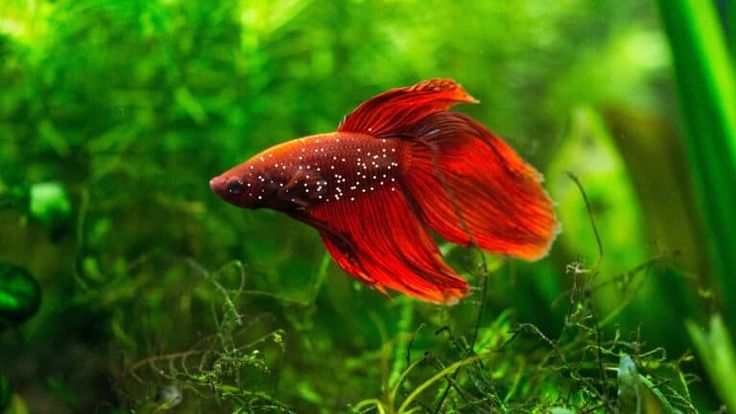
Betta fish are cherished for their vivid colors and unique personalities, but like all fish, they are susceptible to diseases. One of the most common and serious conditions bettas face is Ich, or white spot disease. Ich is caused by the parasite Ichthyophthirius multifiliis, and it can be fatal if not promptly addressed. Understanding Ich’s life cycle, symptoms, and treatment options is going to be key to keeping your betta healthy.
What Is Ich and How Does Ich Spread on a Betta?
Ich, also known as ick or white spot disease, manifests as small, salt-like white spots on the body, fins, and gills of the fish. This parasite has a three-stage life cycle:
- Trophont Stage: The parasite attaches to the fish and feeds, appearing as white specks.
- Tomont Stage: The parasite detaches from the fish, settling in the substrate to reproduce rapidly.
- Theront Stage: The newly hatched parasites swim freely in search of a host, making this phase the most responsive to treatment.
Early Signs of Ich
If your betta develops ich, you’ll have a few visual cues to watch:
Visual Symptoms:
- Small, grain-like white spots on the body and fins.
- White patches may form on the head or gills.
- Potential color loss or ragged fins.
Behavioral Changes:
- Rubbing against tank decorations (flashing) as a response to irritation.
- Lethargy, increased hiding, and reduced activity.
- Labored breathing and clamped fins.
- Refusal to eat, signaling distress.
Outbreaks are often triggered by stressors such as poor water quality, sudden temperature changes, and the introduction of infected fish or plants without quarantine.
Treating Ich Effectively
If a betta has ich, it’s best to immediately move it to a hospital tank to prevent it from spreading to other fish in the tank. Then you’ll want to do the following to the water:
Initial Steps:
- Move the fish to a hospital tank to prevent the spread.
- Gradually increase the temperature to 81-86°F (27-30°C) using a reliable thermometer. This accelerates the parasite’s life cycle.
Medication Options:
Click here for my favorite ich treatment
- Use Ich-specific treatments containing malachite green or methylene blue. Products like Kordon Rid Ich Plus or API Super Ick Cure are popular choices.
- Always remove carbon filters during treatment, as they can absorb the medication.
Alternative Methods:
- Aquarium salt can be used to disrupt the osmotic balance of the parasite. However, it should be used cautiously as not all fish tolerate salt well.
- Maintain frequent water changes, around 25-50% daily, to remove free-swimming parasites and keep the water clean.
Treatment Duration:
- Continue the treatment for at least 7-10 days (or follow the medication instructions if using one). Even after the visible signs of Ich disappear, you’ll want to wait a little bit before transferring them back into their old tank. This ensures all parasites are eliminated, and that you won’t reintroduce it to the main tank.
Preventing Future Outbreaks of Ich
Ich can develop from a multitude of reasons such as stress, water quality, and when adding new fish to the tank. Here are some tips you can keep in mind which should help reduce the chances of ich developing on your bettas.
Quarantine New Arrivals:
- Always isolate new fish or plants for a minimum of two weeks to monitor for potential diseases before introducing them to your tank.
Maintain Excellent Water Quality:
- Regular water changes and monitoring of water parameters can help keep stress levels low and immune systems strong.
Reduce Stress Factors:
- Ensure the tank is spacious enough and free of aggressive tank mates.
- Stabilize water temperature and avoid sudden fluctuations.
Consider Preventative Measures:
- Adding a small amount of aquarium salt at a low dose can serve as a deterrent to parasites without harming your fish.
Helpful Tips for Effective Treatment
- Use a hospital tank for medication if you have sensitive invertebrates or multiple fish in the main tank.
- Provide a balanced diet to strengthen your betta’s immune system.
- Be patient and consistent with the treatment plan, as Ich can be persistent.
Final Thoughts
Prompt recognition and treatment of Ich are essential for the health of your betta fish. Early action, combined with comprehensive prevention strategies, can protect your fish from future outbreaks. Prioritize water quality, reduce stress, and monitor any new tank additions to maintain a thriving aquarium.
Betta Losing Color: Causes, What To Do To Fix
Betta fish, often referred to as the “jewels of the aquarium,” are celebrated for their vibrant colors. Observing a betta’s color fade can be concerning, as it may indicate underlying health or environmental issues. This article explores the potential causes of color loss in bettas and provides actionable steps to restore their vivid hues.
Understanding Betta Coloration
A betta’s striking colors result from specialized cells called chromatophores, which produce pigments influenced by genetics, health, and environmental factors. Sudden or gradual color loss often signals underlying issues that require attention.
Common Causes of Color Loss
Stress
Stress is a primary factor in color fading. Triggers include:
- Environmental Changes: Sudden alterations in tank setup, temperature fluctuations, or relocation can stress bettas.
- Incompatible Tank Mates: Aggressive or overly active companions can intimidate bettas, leading to stress.
- Overcrowding: Limited space can cause territorial disputes, increasing stress levels.
Illness or Disease
Several health issues manifest through color loss:
- Bacterial Infections: Conditions like Columnaris present as white or gray patches and can progress rapidly if untreated.
- Parasitic Infections: Diseases such as Ich (white spot disease) appear as small white lesions, resembling salt grains.
- Fungal Infections: These manifest as cotton-like patches on the skin, leading to color loss.
Poor Water Quality
Elevated levels of ammonia, nitrite, or nitrate can stress bettas, resulting in color fading. Infrequent water changes and inadequate filtration often contribute to deteriorating water conditions.
Aging
As bettas age, a natural dulling of color occurs, especially around the 2 to 3-year mark. This gradual change is typical and not necessarily indicative of health issues.
Dietary Deficiencies
A lack of nutrients can lead to diminished coloration. Bettas require a protein-rich diet to maintain their vibrant hues.
Diagnostic Steps
Behavioral Observation
Monitor for signs like lethargy, reduced appetite, or unusual swimming patterns, which can indicate stress or illness.
Physical Examination
Look for visible symptoms such as fin damage, spots, or lesions that might suggest infections or parasites.
Water Testing
Regularly assess water parameters using reliable test kits to ensure optimal conditions.
Preventive Measures and Solutions
Stress Reduction
- Stable Environment: Maintain consistent tank conditions, including temperature and lighting.
- Proper Tank Mates: Choose compatible species that coexist peacefully with bettas.
- Adequate Space: Provide at least a 5-gallon tank for a single betta to reduce territorial stress.
Disease Prevention and Treatment
- Quarantine New Additions: Isolate new fish or plants before introducing to the main tank to prevent potential infections.
- Prompt Treatment: We recommend using this care guidebook (page 38 covers this in detail.)
Water Quality Management
- Regular Maintenance: Perform consistent partial water changes, typically 25-30% weekly, to maintain cleanliness.
- Efficient Filtration: Ensure the filtration system is suitable for the tank size and bioload.
Nutritional Support
- Balanced Diet: Offer high-quality betta pellets supplemented with live or frozen foods like brine shrimp and bloodworms.
- Avoid Overfeeding: Feed small portions to prevent obesity and water contamination.
Conclusion
Maintaining the vibrant colors of your betta involves attentive care, a stable environment, and a nutritious diet. Regular observation and prompt intervention can ensure your betta remains healthy and dazzling.
What Is Betta Fish Dropsy & How To Treat It
Dropsy in betta fish is not a disease but a symptom of a deeper internal problem. It typically signals organ failure, a bacterial infection, or another systemic issue. The most recognizable sign of dropsy is raised scales that give the fish a pinecone-like appearance due to internal swelling and fluid retention.
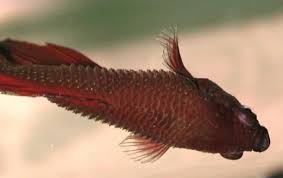
credit: betta fish forum: pineconing of the fins
Quick Summary: Dropsy in Betta Fish
- Cause: Bacterial infection, kidney failure, poor water quality
- Symptoms: Bloating, pinecone scales, lethargy, appetite loss
- Treatment: Isolate fish in a quarantine tank, aquarium Epsom salt, Kanaplex or Maracyn Two
- Outlook: Often fatal if not caught early
- Prevention: Clean tank, check for stable water using a testing kit, and look at the food you’re feeding them — use high-quality betta food
Early Symptoms of Dropsy in Bettas
Catching dropsy early is critical. Here are the signs to watch for:
- Swollen belly that affects the whole body, not just the stomach area
- Pinecone-like scales when viewed from above
- Lethargy and lack of movement
- Loss of appetite, even when offered favorite foods
- Color fading or a pale appearance
- Bottom-sitting or floating sideways
- Gasping at the surface for air
Tip: Compare your betta to images of healthy fish. A side-by-side comparison often reveals changes more clearly.
What Causes Dropsy in Betta Fish?
Dropsy is most often caused by a gram-negative bacterial infection, but many contributing factors can trigger it:
- Kidney or liver failure that prevents fluid regulation
- Poor water quality, such as high ammonia or nitrite levels
- Sudden temperature changes or cold water
- Overfeeding and poor diet
- Stress from overcrowding or aggressive tank mates
- Old age, which makes bettas more susceptible to internal failures
How to Treat Dropsy in Betta Fish
Step-by-Step Treatment:
- Move your betta to a hospital tank with clean, warm water (78–80°F).
- Lower the water level to help the fish reach the surface easily.
- Add an air stone to improve oxygenation.
- Add Epsom salt (0.5 teaspoons per gallon). Make sure it’s fully dissolved.
- Administer antibiotics:
- Kanaplex (kanamycin-based) or
- Maracyn Two (minocycline-based)
- Follow the dosage instructions strictly. Don’t stop treatment early.
- Keep your main tank separate. Do not return hospital water to it afterward.
Note: If your betta is no longer eating, choose medications that are absorbed through the skin and gills.
Is Dropsy in Bettas Curable?
Dropsy is often fatal in advanced cases. If caught early, treatment may work. Many fish do not survive, but some recover with aggressive early care.
In cases where your fish is severely bloated, not responding to treatment, and suffering, humane euthanasia may be the most compassionate choice.
How to Prevent Dropsy in Betta Fish
Prevention is key:
- Keep your tank clean and cycled – use a testing kit
- Maintain a steady tropical temperature with a heater (78°F)
- Feed high-quality food in small portions
- Test water regularly for ammonia, nitrite, and nitrate
- Quarantine new tank mates or live foods before introducing them
Recommended Medications for Dropsy
| Medication | Brand | Active Ingredient | Where to Buy |
|---|---|---|---|
| Kanaplex | Seachem | Kanamycin | Amazon link |
| Maracyn Two | Fritz Aquatics | Minocycline | Amazon link |
These antibiotics are known to help treat internal bacterial infections responsible for dropsy. Use only as directed.
Click here if your betta has stopped eating altogether or if the betta is floating near the top as it might be swim bladder. We also have a full list of diseases here.
How To Clean a Betta Fish Tank For Beginners
Cleaning your betta fish tank is crucial for maintaining your fish’s health and happiness. This step-by-step guide walks you through everything you need to know—from prepping your betta’s temporary home to safely reintroducing them to their clean tank.
Click here for my favorite betta tank cleaning kit
Step-by-Step Betta Tank Cleaning
Step 1: Prepare the Temporary Home
Fill a container with dechlorinated water that matches the tank temperature. Use a net or cup to gently transfer your betta to this temporary home.
Step 2: Remove a Portion of the Water
Scoop out 25-50% of the current tank water and pour it into a clean bucket. You’ll reuse some of this water to help your betta acclimate.
Step 3: Unplug Equipment
For safety, turn off and unplug any filters, heaters, and lights before proceeding.
Step 4: Remove Decorations and Plants
Take out any tank decor or live/artificial plants. Rinse them in some of the removed tank water or fresh dechlorinated water.
Step 5: Vacuum the Gravel
Use a gravel vacuum to clean the tank substrate. Work in sections to remove uneaten food, waste, and debris.
Step 6: Clean the Glass
Scrape off algae using an algae scraper. Wipe down the tank’s interior with a soft cloth or sponge soaked in old tank water.
Step 7: Reassemble and Refill
Return the decorations and plants to the tank. Slowly refill with dechlorinated water, ensuring the temperature matches the original water.
Step 8: Acclimate and Return Your Betta
Allow the new water to reach room temperature (72-80°F). Acclimate your betta by gradually mixing some of the new water into the temporary container. Then gently net and transfer your betta back into the tank.
Step 9: Reconnect Equipment
Plug in and restart your filter and heater. Monitor the temperature and water conditions to ensure a smooth transition.
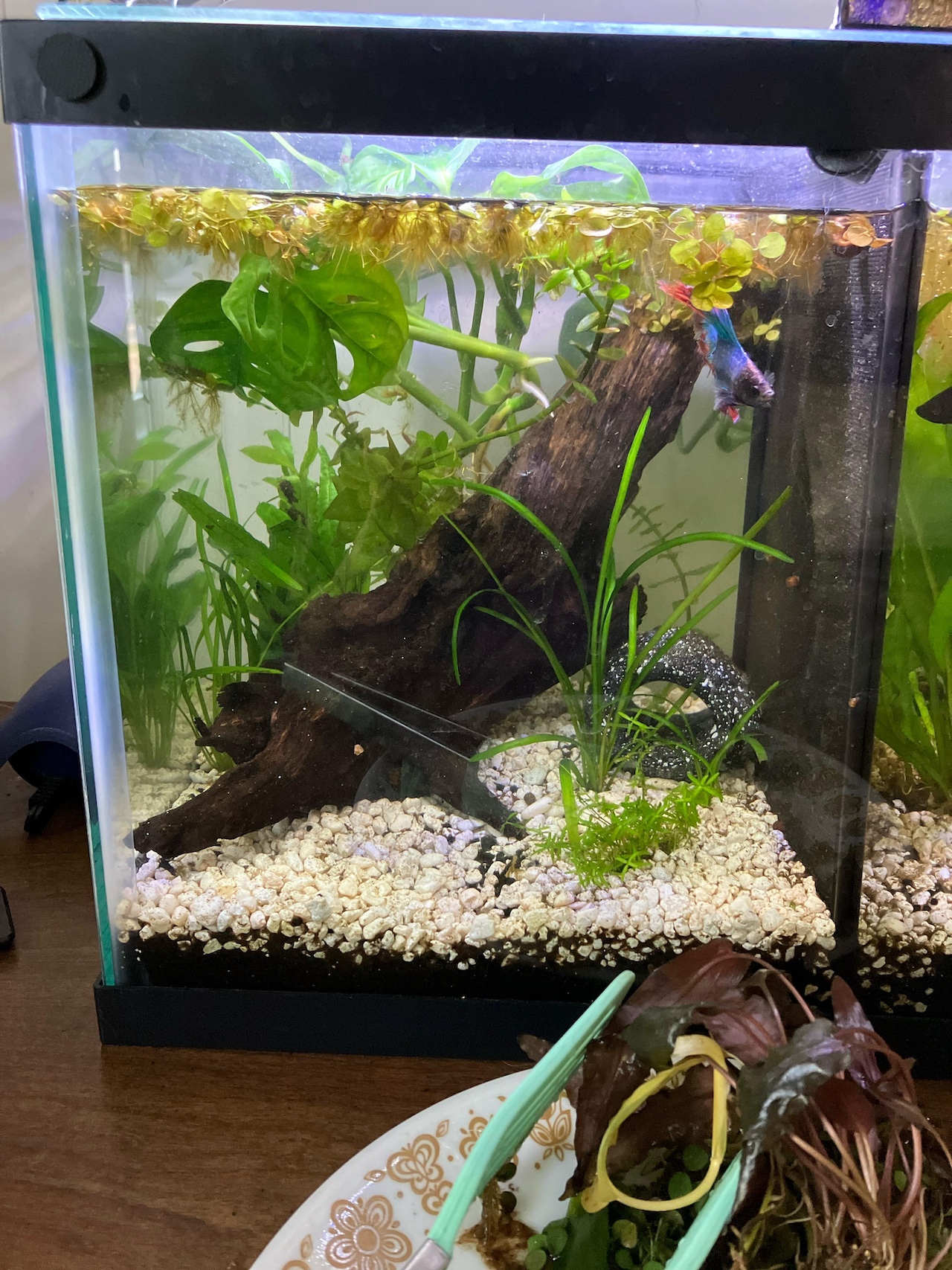
credit reddit.com
Why a Clean Tank is Important
- Prevents Disease: Waste and uneaten food break down into harmful ammonia and nitrites.
- Promotes Well-Being: Clean water boosts coloration, behavior, and immune health.
- Reduces Algae: Consistent cleaning controls unsightly algae buildup.
Essential Supplies for Betta Tank Cleaning
- Temporary Container: Clean, fish-safe bowl or tub
- Water Conditioner: Neutralizes chlorine and chloramines
- Bucket: Used only for aquarium maintenance
- Gravel Vacuum: Removes debris from substrate
- Algae Scraper: For removing algae buildup
- Soft Cloth or Sponge: For wiping interior glass
- Paper Towels: For cleaning up drips and spills
How Often Should You Clean a Betta Fish Tank?
- Small Tanks (<5 gallons): Once per week
- Larger Tanks (5+ gallons): Every 1–2 weeks
- Unfiltered Tanks: Multiple times weekly
Extra Betta Tank Cleaning Tips
- Never Use Soap: Soap is toxic to fish—use only clean, dechlorinated water.
- Match Water Temperature: Sudden changes can shock your fish.
- Quarantine New Items: Rinse new decorations before adding them.
- Always Use Conditioner: Vital for removing harmful chemicals.
- Maintain Neutral pH: Aim for 7.0; test before reintroducing your betta.
Frequently Asked Questions
Click here for the secrets to simple, happy betta fish care…
How often should I clean my betta tank?
Small tanks need weekly cleaning; larger tanks may only need it every 1–2 weeks if filtered.
Can I use some kind of soap to clean the tank?
No. Soap can leave behind residues that are lethal to fish.
Do I need to remove my betta while cleaning?
Yes. It’s safer for your betta to stay in a temporary home during cleaning.
What’s the safest way to reintroduce my betta?
Acclimate them slowly to the new water by mixing it with their temporary water before transferring.
Is My Betta Fish Pregnant?
A common misconception exists regarding the reproductive process of betta fish. While some fish species are indeed viviparous (livebearers), bettas are oviparous (egg-layers). This distinction is crucial, as females develop eggs that are subsequently released and fertilized externally rather than carrying embryos internally until birth. In other words, a betta fish is never ‘pregnant’, but it might be full of eggs ready to lay.
Here’s the scoop on betta breeding:
- Betta Fish Eggs: Female bettas develop eggs, and their bellies may appear plump. This doesn’t mean they’re pregnant, just ready to spawn (release eggs) if a male is present. Eggs hatch in about 3 days. We have an article that talks more about the eggs and egg nests here.

Egg spot shown here – credit: reddit user Sea-Explanation4816
- The Spawning Dance: If a male betta is in the tank, he’ll build a bubble nest and court the female. If she’s interested, she’ll release eggs, and the male will fertilize them and place them in the bubble nest.
- No Womb: Unlike livebearers (like guppies), bettas don’t carry fertilized eggs inside them. The eggs develop in the bubble nest until they hatch.
So, what if your betta looks plump and there’s no male around?
- Not All Puff is Pregnancy: Bettas can bloat due to overfeeding or constipation. Observe their behavior and droppings to rule these out. We have a guide on betta diseases and ailments which can help diagnose the issue.
- Egg Absorption: If there’s no male, the female will eventually reabsorb the eggs.
Want to learn more about betta breeding?
If you’re interested in breeding bettas, there’s a whole world to explore! Research proper tank setup, breeding techniques, and raising baby bettas (fry). I suggest getting a guidebook if your betta is laying eggs with a male around, because soon enough you might need some additional information.
Swim Bladder Disease Betta: How To Identify Symptoms, Treat It, Get a Healthy Betta
Swim bladder disease (SBD) is one of the most common health concerns betta fish owners face. When a betta starts floating on its side or struggles to stay submerged, it can be alarming. The good news is that SBD is often treatable and preventable with the right care. In this guide, you’ll learn everything you need to know about swim bladder disease: what it is, what causes it, how to treat it, and how to prevent it in the future.
🛠️ How to Treat Swim Bladder Disease
1. Fast Your Betta (1–3 Days) Give your betta a break from food to let its digestive system rest and clear.
2. Adjust the Diet If constipation is suspected, offer a small piece of cooked, deshelled pea or high-fiber food like daphnia.
3. Improve Water Conditions Keep the tank clean and maintain a temperature between 78–82°F. Stable, pristine water helps recovery. Test your water using a testing kit.
4. Lower the Water Level Reducing water depth to 8–10 cm helps the fish reach the surface more easily.
5. Use Medication (If Necessary) If you suspect infection, consider using antibacterial treatments like Kanaplex which is suitable for aquarium use.
6. Epsom Salt Bath (Optional) Use aquarium Epsom salt 1 tablespoon per gallon of conditioned water for 10–15 minutes may reduce inflammation. Monitor your fish closely.
🧠 What Is Swim Bladder Disease (SBD)?
Click here for our betta fish ebook health guide
Swim bladder disease isn’t technically a disease—it’s a condition that results from problems with a betta fish’s swim bladder, a gas-filled organ that controls buoyancy. When the swim bladder is impaired, the fish loses its ability to maintain balance in the water. SBD can make your betta float uncontrollably, sink to the bottom, or swim sideways.
Importantly, SBD is not contagious. It’s usually a symptom of an underlying issue such as overfeeding, poor water quality, or infection.
🚨 Symptoms of Swim Bladder Disease in Bettas
- Floating sideways or upside down
- Sinking to the bottom of the tank
- Struggling to swim upright
- Erratic or spiraling swimming behavior
- Swollen abdomen
- Loss of appetite
- Lethargy or staying in one spot
Note: A swollen belly from SBD can sometimes be mistaken for dropsy, which involves raised scales and is usually more serious.
🔍 Causes of Swim Bladder Disease
- Overfeeding & Constipation: Excess food leads to digestive pressure on the swim bladder.
- Poor Water Quality or Temperature Swings: Sudden changes or unclean water can stress your fish.
- Bacterial Infection: Can inflame or damage the swim bladder.
- Physical Injury: Rough handling or jumping out of the tank.
- Genetic Factors: Some bettas, especially fancy breeds, are more prone to swim bladder issues.
❌ Treatments to Avoid (Myths vs Facts)
- Aquarium Salt: Only helps with external bacterial infections, not swim bladder issues.
- Peas as a Cure-All: Only effective if constipation is the root cause.
- Overmedicating: Can stress your fish further if the wrong issue is being treated.
🛡️ How to Prevent Swim Bladder Disease
- Feed Properly: Small, consistent meals once or twice a day. Avoid overfeeding.
- Keep the Water Clean: Regular water changes and filtration are essential.
- Control the Temperature: Maintain a stable range of 78–82°F.
- Reduce Stress: Avoid overcrowded tanks and give your betta hiding spots.
- Choose Quality Food: High-quality pellets and occasional treats like bloodworms or brine shrimp.
🔬 Is It SBD or Something Else?
| Symptom | Likely SBD | Possibly Dropsy |
|---|---|---|
| Floating sideways | ✅ | ❌ |
| Swollen belly | ✅ | ✅ |
| Appetite loss | ✅ | ✅ |
| Pineconing scales | ❌ | ✅ |
| Clamped fins | ✅ | ✅ |
🏡 Bonus: Download Our Free Betta Health Tracker
Keep tabs on water parameters, behavior, and symptoms. Catch illnesses early.
📃 Frequently Asked Questions
Can a betta recover from swim bladder disease? Yes, most cases improve with proper care and fasting.
How long does it take to heal? Anywhere from a few days to over a week, depending on the cause.
Should I isolate my betta? Not always necessary, but it may reduce stress and help monitor recovery.
Can swim bladder disease be fatal? Rarely, unless caused by a severe infection or internal organ failure.
Is SBD painful for fish? It can cause discomfort but is generally not painful if treated promptly.
Betta Fish Sickness, Diseases, Illness, Problems Troubleshooting & Behavior Before Death

Sick Betta Fish Behavior
Click for our favorite betta fish care book
Recognizing the signs of disease, including changes in appetite, lethargy, fading colors, and fin clamping, is crucial for early intervention if your betta fish is sick. Not only do you want to step in immediately and make some changes, but understanding the subtle cues that may signal impending death, such as difficult breathing, erratic swimming, and prolonged inactivity, can be good indicators of the steps you need to take to save their life.
Betta fish behavior before death
Signs your betta fish might be dying. If you suspect your betta is very sick, click here to read more on behavior before death.
- Bloat: Can be caused by dropsy (see more below), overfeeding, constipation, a diet lacking in variety, or infections.
- Lethargy: A healthy betta is curious and active. If your fish rests at the bottom of the tank for extended periods or shows little interest in swimming, this is a cause for concern.
- Loss of Appetite: Bettas normally have healthy appetites. Refusal of food or spitting it out can indicate illness.
- Faded Color: Betta fish are known for their vibrant colors; fading is often a sign of deteriorating health. We have an article on bettas losing color here.
- Difficulty Breathing: Rapid or labored breathing at the surface could mean trouble getting oxygen and is a serious sign.
- Clamped Fins: Betta fins normally flow gracefully; keeping them tightly pressed to the body is a sign of stress or illness.
- Difficulty Swimming: Bettas floating on one side or sinking to the bottom of the tank.
Guide to Betta Fish Diseases and Ailments
Here’s a table that breaks down common betta illnesses, symptoms, and signs that something is wrong.
| Disease or Condition | Indicative Signs | Probable Causes |
Sick Betta Fish Care
|
|---|---|---|---|
| Columnaris | Fluffy, white patches on body or gills | Bacterial invasion in poor-quality water | Quarantine, administer antibacterial treatment, enhance tank cleanliness |
| Dropsy | Swollen body, scales sticking out | Infections leading to organ failure | Isolation, Epsom salt for swelling, seek specific antibiotics |
| Hole in Head | Depressions or holes near the head region | Nutritional deficiencies, low-quality water | Nutritional supplementation, water quality improvement |
| Ich/Ick | Tiny white specks covering fins and body | Infestation by Ichthyophthirius multifiliis parasites | Increase water temperature, salt treatment, specialized medications |
| Fin & Tail Rot | Eroding, fraying fins and tail | Fungal, parasitic, or bacterial infections, deteriorating water conditions | Clean water imperative, fungal or bacterial specific treatments |
| Popeye | Noticeable eye protrusion | Injury or bacterial infection causing fluid buildup | Improve water quality, consider antibiotics for bacterial causes |
| Swim Bladder Disease | Trouble maintaining buoyancy, floating or sinking | Improper diet, abrupt water changes | Offer dietary adjustments, ensure optimal water conditions |
| Betta Fish Tumor | Abnormal growths or swellings | Genetic predispositions, environmental factors | Maintain quality of life, consult vet for potential treatments |
| Velvet | Rusty or gold dust appearance on the body | Oodinium pillularis parasite | Reduce tank light, copper or malachite green treatment |
| Septicemia | Red lines or spots on body, lethargy | Bacterial infection in the bloodstream | Immediate antibiotic treatment, improve tank sanitation |
| Constipation | Difficulty in excretion, bloated abdomen | Overfeeding, lack of dietary fiber | Fasting followed by feeding fibrous foods like peas |
| Lethargy | Reduced activity, indifference to surroundings | Suboptimal water temperature, stress, toxins in water | Regulate water temperature, ensure cleanliness, minimize stress |
| No Appetite | Disinterest in food | Temperature fluctuations, advanced age, stress, illness | Investigate and rectify underlying issues, temperature control |
| Tail Biting | Self-inflicted injuries to the tail | Environmental stress, lack of stimulation | Enrich habitat with plants/toys, monitor for stress signs |
Columnaris
Also known as “cotton mouth,” Columnaris is a bacterial infection that presents as white or grayish spots and patches on the body and around the mouth and gills. If not addressed promptly, it can rapidly deteriorate the health of your fish.
- Tips:
- Quarantine the affected fish immediately to prevent the spread of bacteria.
- Treat the water with antibacterial medicine designed explicitly for Columnaris. Furan-2 and Kanamycin are effective options.
- Maintain high water quality through regular changes and removing uneaten food and debris.
Dropsy
Dropsy is not a disease but a symptom of underlying issues, often kidney failure. It manifests as severe bloating and raised scales, giving the body a pinecone-like appearance (fish scales sticking out). Read more on Dropsy here.
- Tips:
- While difficult to treat, early detection improves chances. Begin with isolating the affected betta.
- Offering a warm bath with Epsom salt can help reduce fluid retention.
- Consultation with a veterinarian for possible antibiotic treatments is recommended, though recovery chances remain slim.
Ich/Ick
Ichthyophthirius multifiliis, commonly known as Ich or Ick, is a parasitic infection recognizable by white, grain-like dots covering the betta fish’s body and fins. It’s highly contagious and stressful for the fish, if you suspect the parasite in your betta read on…
- Tips:
- Increase the tank’s temperature gradually to 86°F over 24 hours to speed up the parasite’s life cycle.
- Add aquarium salt at 1 teaspoon per gallon of water to help the fish produce more slime coating, offering protection against the parasite.
- Use over-the-counter Ich treatment, following the instructions carefully. Treatment should continue for at least a week to ensure all parasites, including those in the larval stage, are eradicated.
Fin & Tail Rot
Fin rot, a common affliction in betta fish, is characterized by fraying, discoloration, and receding edges on the fins. It’s often caused by poor water quality or a bacterial infection. Read more on fin rot here.
- Tips:
- Regularly clean the tank and change the water to improve conditions.
- Treat the tank with antibacterial medications, such as Maracyn or tetracycline-based products, to combat bacterial causes.
- For fungal causes, antifungal treatments like Pimafix can be effective.

Fin rot
Credit: Petco
Velvet
This parasitic disease, caused by the dinoflagellate parasite, presents as a gold or rust-colored dusting on the betta’s body. Affected fish may scratch against objects due to irritation. Click here to learn more on diagnosing and treating velvet.
- Tips:
- Quarantine the infected fish to prevent spreading to tank mates.
- Treat the tank with copper-based medications or malachite green, following dosage instructions precisely.
- Reduce lighting in the tank, as the parasite thrives in well-lit conditions.
Popeye
Popeye is an infection that causes one or both eyes to bulge outward. It can result from bacterial infections or physical injuries.
- Tips:
- Improve water quality to reduce the chance of infection.
- In cases of bacterial popeye, antibiotics can be effective.
- For injury-induced popeye, ensure the tank is safe and free of sharp decorations that could harm the fish.
Swim Bladder Disease
Swim bladder disease affects the fish’s ability to control buoyancy, resulting in floating or sinking. Overfeeding, constipation, or water quality issues might be the cause. Read all about swim bladder here.
- Tips:
- Ensure the water is at an appropriate temperature and quality to support digestion and reduce stress.
- Avoid overfeeding and provide a diet with variety to prevent future occurrences.
- Read about betta fish care and use their guidebook for treatment
Tumor
Tumors can appear as abnormal growths on the body or inside the betta. They may be benign or malignant and can vary in treatability.
- Tips:
- Little can be done at home for tumors; maintaining a stress-free environment is critical.
- Regularly monitor the tumor for changes and consult a veterinarian specialized in fish if significant changes occur.
Septicemia
Septicemia is a systemic bacterial infection that causes red streaks or spots on the body, lethargy, and loss of appetite. It is often fatal if not treated promptly.
- Tips:
- Immediate antibiotic treatment is necessary. Consult a vet for the best course of action.
- Improve tank conditions to prevent future infections. Regular water changes and monitoring for stressors are essential.
Constipation
A common issue due to overfeeding or a lack of dietary fiber, constipation is evident if your betta has a swollen belly and difficulty defecating.
- Tips:
- Fasting the fish for a few days can help clear its system.
- Feeding a small, cooked, peeled pea can aid digestion and relieve constipation.
Lethargy
If your betta is less active than usual, it could be due to cold water, poor water quality, or stress.
- Tips:
- Ensure the water temperature is stable and within the ideal range for bettas (76-81°F).
- Test the water regularly and keep the tank clean to prevent stress from poor water conditions.
No Appetite
A betta might lose its appetite for various reasons, including stress, water temperature changes, or illness.
- Tips:
- Investigate and correct any environmental stressors or water quality issues.
- Try offering different types of food to stimulate appetite, ensuring they are appropriate for bettas.
Tail Biting
Stress or boredom can lead bettas to bite their tails, causing injury and potentially leading to fin rot.
- Tips:
- To prevent boredom, provide ample enrichment in the tank, such as plants and hiding places.
- Regularly change the layout of the tank to offer new stimuli.
Actions To Take for a Dying Betta Fish
- Test Water Quality: Ammonia, nitrite, and nitrate build-up are the most common and dangerous issues in tank fish. Test immediately and address them with water changes if necessary.
- Check Temperature: Bettas need 76-82°F. A drastic change or consistently low temperature causes severe stress. Adjust with a heater if needed.
- Look for Disease Signs: Lethargy is often caused by illness. Look for additional symptoms like:
- Bloating
- White spots or patches
- Fin damage or discoloration
- Difficulty breathing at the surface
Addressing Urgent Problems
- Ammonia/Nitrite Poisoning: Perform water change (use water conditioner)
- Add ammonia neutralizer if levels remain high
- Continue daily water changes until the problem is resolved
- Temperature Issues: If too cold, use a heater
- If it is too hot, float bags of ice temporarily and find the cause (broken heater, sunlight, etc.)
- Suspected Disease: Consult a betta disease guide online for specific symptoms and treatments.
- Consider using a quarantine tank for treatment to avoid medicating the main tank unnecessarily.
Other Possible Causes and Solutions
- Appetite Loss: Try frozen or live food (daphnia, brine shrimp) for stimulation
- Fast for 24-48 hours if bloating is suspected
- If prolonged, consider internal parasites or other illnesses
- Color Changes: Look for other signs to pinpoint stress, disease, or natural aging.
- Maintain excellent water quality for long-term improvement.
- Behavioral Changes (Lethargy, Hiding, etc): Watch for tank bullies and adjust if necessary.
- Ensure enough hiding places with plants or decorations.
- Improve overall tank size and conditions.
Prevention Strategies
The cornerstone of betta fish care is prevention. Many common ailments can be avoided with the correct practices:
- Water Quality: Regularly test and maintain the parameters (ammonia, nitrite, nitrate levels, pH, and temperature) within the ideal range for betta fish.
- Nutrition: Feed your betta a varied diet, avoiding overfeeding. Mixing high-quality pellets, frozen, and live foods can provide balanced nutrition.
- Environmental Enrichment: Keep your betta stimulated with a well-decorated tank that includes hiding spots and plants. A bored betta is a stressed betta, more susceptible to illness.
- Regular Monitoring: Regularly observe your betta for signs of distress or disease. Early detection is critical to effective treatment.
Caring for a betta fish is a rewarding endeavor that comes with its set of challenges. Understanding the signs of common diseases and how to address them is crucial for any betta owner. You can enjoy your betta’s beauty and companionship for years by staying vigilant and providing a clean, enriching environment. If you believe your betta is actively unhealthy and dying, click here to learn more.
Why Won’t My Betta Fish Eat & Acting Lethargic
As a betta owner, there’s nothing more worrying than seeing your once-vibrant fish suddenly lose interest in food. It can be frustrating and even a little scary when you don’t know the cause. This guide will walk you through the most common reasons why your betta won’t eat and give you simple steps to get them back on track.
How To Get Your Betta’s Appetite Back
To get your betta to start eating again, consider these factors and address them promptly. Fix the root cause of the problem, and the betta is more likely to recover.
- Stress: Betta fish are sensitive to environmental changes and easily become stressed. Poor water quality, improper tank setup, bullying from tank mates, or even changes in their routine.
- Illnesses: Betta fish are prone to several diseases that affect their appetite, including fin rot, swim bladder disease, and bacterial infections.
- Poor water quality: Betta fish require clean, well-maintained water to thrive. High ammonia, nitrite, or nitrate levels can cause stress and illness, leading to a loss of appetite.
- Change in diet: If you have recently switched your betta fish’s food, they may not like the new flavor or texture.
- Overfeeding: Betta fish can quickly become overfed. If you are feeding them too much, they may refuse to eat.
- Constipation: If a betta fish is constipated, they may not feel like eating. This can be caused by a diet that is too high in protein or fiber.
- Old age: As betta fish age, their metabolism slows down, and they may naturally eat less.
Betta Fish Not Eating – Troubleshooting Guide
Click here for a betta fish ebook health guide
Bettas are sensitive creatures. When dealing with water quality issues, illness, or environmental stress, it’s better to make gradual adjustments rather than significant, sudden changes. For example, if the water temperature is too low, raise it slowly by 1-2 degrees Fahrenheit daily rather than all at once. This helps minimize further stress for your fish. If you need more information on how long a betta can last without food click here.
1. Check the Basics:
- Water Quality:
- Test your tank water with a reliable aquarium test kit. Look for ammonia, nitrite, nitrate, and pH levels.
- Bettas are sensitive to fluctuations and especially to the presence of ammonia or nitrite which are toxic.
- If any levels are off, perform a partial water change (25-30%) and consider using a water conditioner to remove chlorine/chloramine and heavy metals from tap water.
- Remember: Regular small water changes are crucial for maintaining optimal conditions.
- Temperature:
- Use an accurate aquarium thermometer to ensure the water temperature is stable between 78-80°F (25-26°C).
- Rapid changes or a temperature that’s too low can suppress a betta’s appetite. A heater is recommended for most setups.
2. Food Matters:
Click Here if You’re Ready for a Thriving, Vibrant Betta
Sometimes, bettas can be picky eaters. If they’re rejecting the food you usually provide, here are some things to try:
- Live Food: Small amounts of live food, such as brine shrimp or daphnia, can awaken a betta’s hunting instincts and stimulate its appetite.
- Garlic Enticement: Soak your betta’s usual food in a bit of garlic juice (from fresh, crushed garlic). The scent can encourage them to eat.
- Variety is Key: Switch between different high-quality betta foods to see if a new formula is more appealing.
- Quality:
- Offer high-quality betta-specific foods; avoid generic fish flakes. Check expiration dates before feeding.
- Old or stale food loses nutritional value and becomes less appealing.
- Type:
- A varied diet is more stimulating. Rotate between pellets, flakes, and occasional frozen or freeze-dried treats like bloodworms or brine shrimp.
- Experiment to see what your betta prefers.
- Soaking:
- Freeze-dried foods and dry pellets should be soaked for a few minutes in tank water before feeding. This softens them and reduces the risk of bloating.
- Size:
- Bettas have tiny mouths! Crush larger food items into bite-sized pieces.
3. It Might Be Sick:
Before trying any solutions, take a few minutes to simply observe your betta. Note their overall behavior, swimming patterns, and any unusual physical changes. Are their fins clamped close to their body? Are they unusually inactive or hiding consistently? Is there any bloating, discoloration, or strange growths? These observations will guide you towards the most likely reason behind their loss of appetite.
-
Symptoms:
- Lethargy (unusual inactivity)
- Clamped fins (fins held close to the body)
- Visible spots, fuzzy growths, or discoloration
- Bloating or unusual body shape
- Loss of appetite is often a symptom of underlying illnesses in bettas.
-
Research:
- Observe your betta closely. Use the symptoms to research common betta diseases (e.g., fin rot, ich, swim bladder disease)
- Consider consulting a fish veterinarian or an experienced aquarist if you suspect illness.
4. Environmental Factors:
Click Here To Create the Perfect Betta Home
- Stress:
- New tank setups, recent changes, overstimulation from tank mates, or harsh lighting can cause bettas to feel stressed and lose their appetite.
- Provide a calm environment with places to hide, such as plants or decorations. Reduce strong water flow.
- Light:
- Aim for about 8 hours of gentle, indirect light. Bettas need a regulated day/night cycle, and too much light can be stressful.
Additional Tips:
- Fasting: If your betta appears otherwise healthy, a 1-2 day fast can help reset the appetite.
- Small Portions: Offer only what your betta can consume in 2-3 minutes, twice a day. Overfeeding contributes to poor water quality and can make your fish less interested in food.
- Patience: New environments or fussy eaters might need time. Continue consistently offering small amounts of appropriate food.














